University Finance: Management and Cost Accounting Exam Solution
VerifiedAdded on 2023/01/03
|17
|2620
|100
Homework Assignment
AI Summary
This document provides a comprehensive solution to an online exam in Management and Cost Accounting. The solution covers various topics, including activity-based costing (ABC) with calculations of activity rates, overhead allocation, and unit manufacturing costs. It also includes variance analysis for direct materials and labor, examining price and efficiency variances, and explores the impact of discounts on profitability. The solution further addresses break-even analysis, calculating the number of units needed to achieve a target after-tax profit and the required revenue. Finally, it presents a debtor schedule and a cash budget, analyzing cash inflows and outflows to assess the feasibility of a new project. The document includes detailed calculations, explanations, and journal entries where applicable, providing a thorough understanding of the concepts discussed.
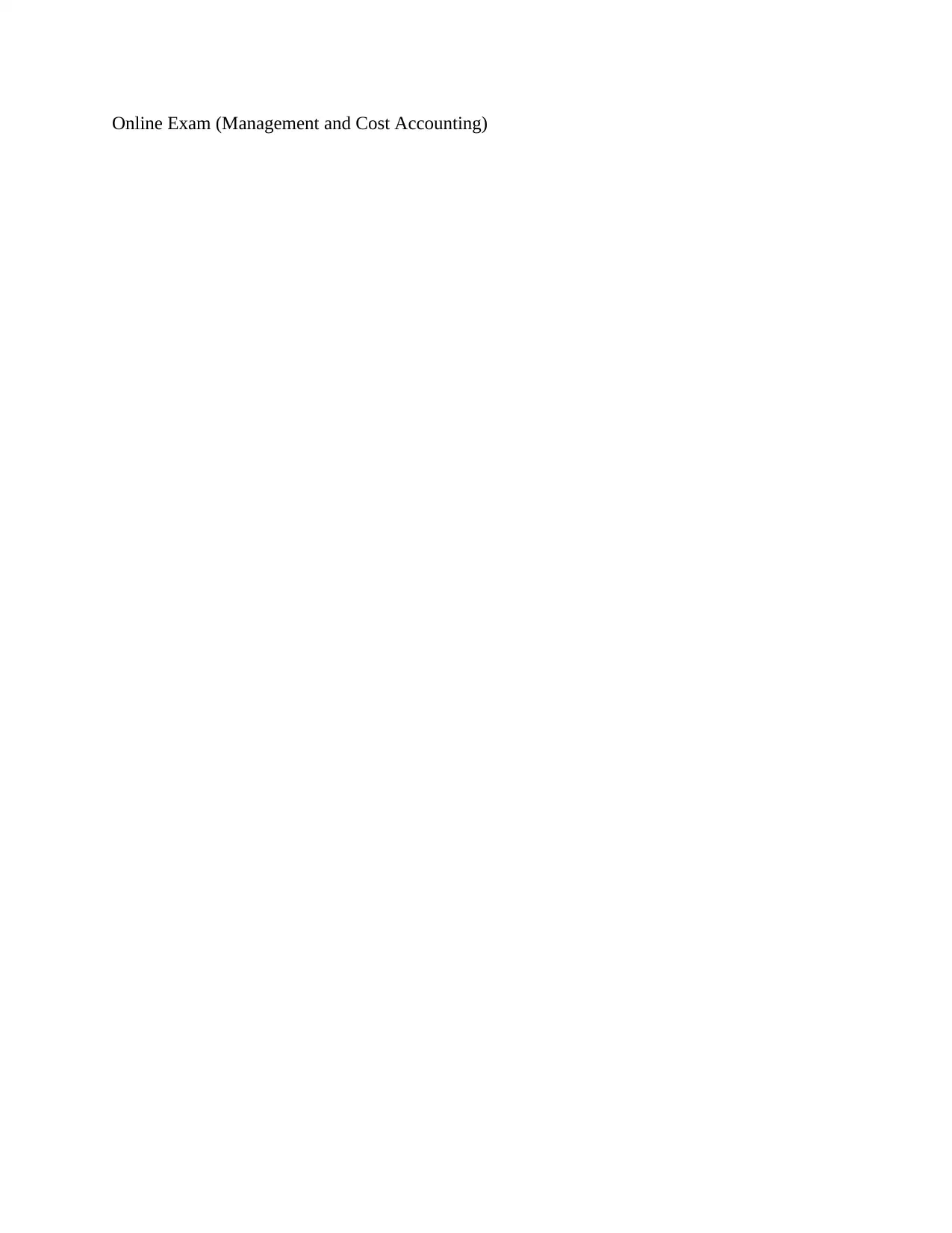
Online Exam (Management and Cost Accounting)
Paraphrase This Document
Need a fresh take? Get an instant paraphrase of this document with our AI Paraphraser
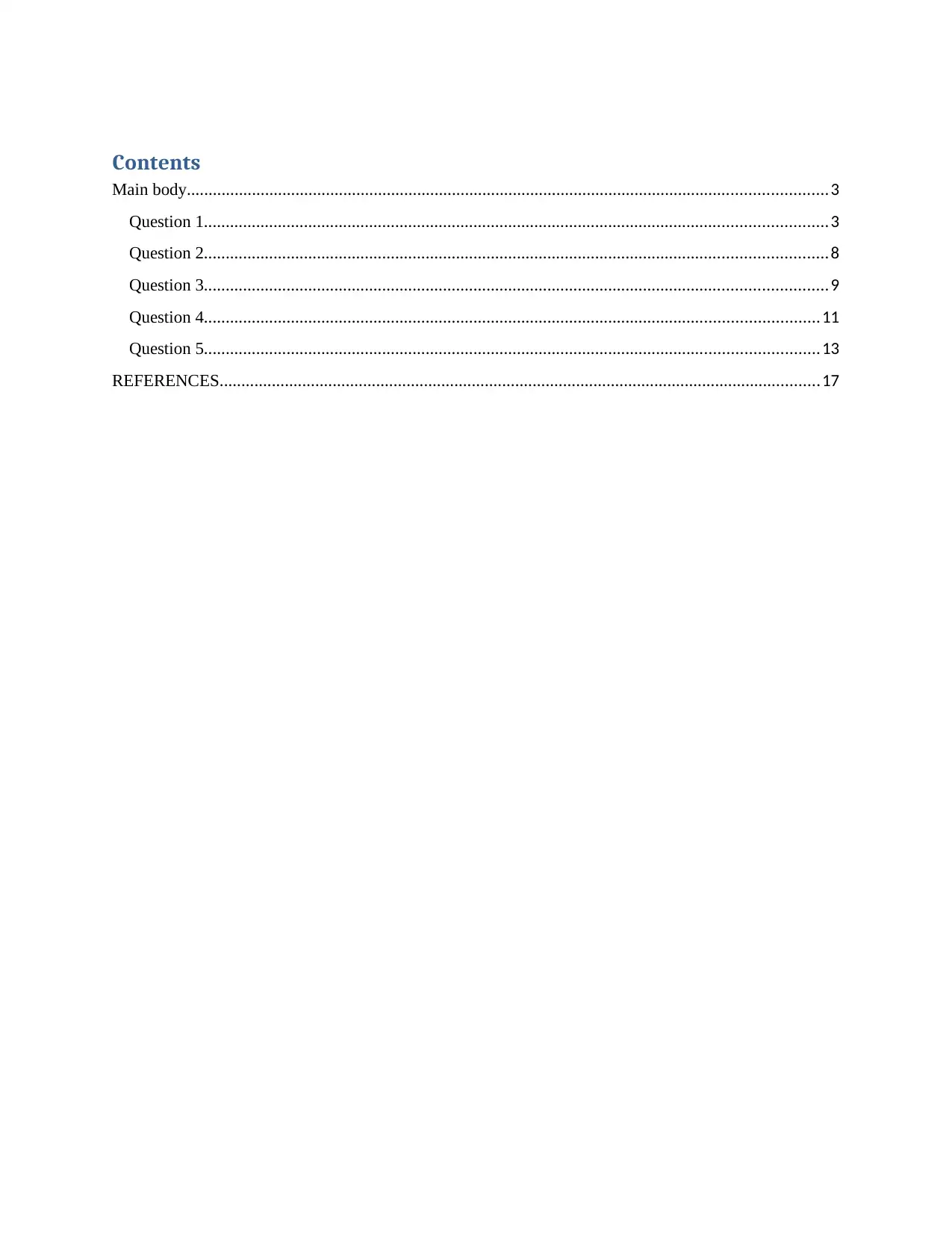
Contents
Main body...................................................................................................................................................3
Question 1...............................................................................................................................................3
Question 2...............................................................................................................................................8
Question 3...............................................................................................................................................9
Question 4.............................................................................................................................................11
Question 5.............................................................................................................................................13
REFERENCES..........................................................................................................................................17
Main body...................................................................................................................................................3
Question 1...............................................................................................................................................3
Question 2...............................................................................................................................................8
Question 3...............................................................................................................................................9
Question 4.............................................................................................................................................11
Question 5.............................................................................................................................................13
REFERENCES..........................................................................................................................................17
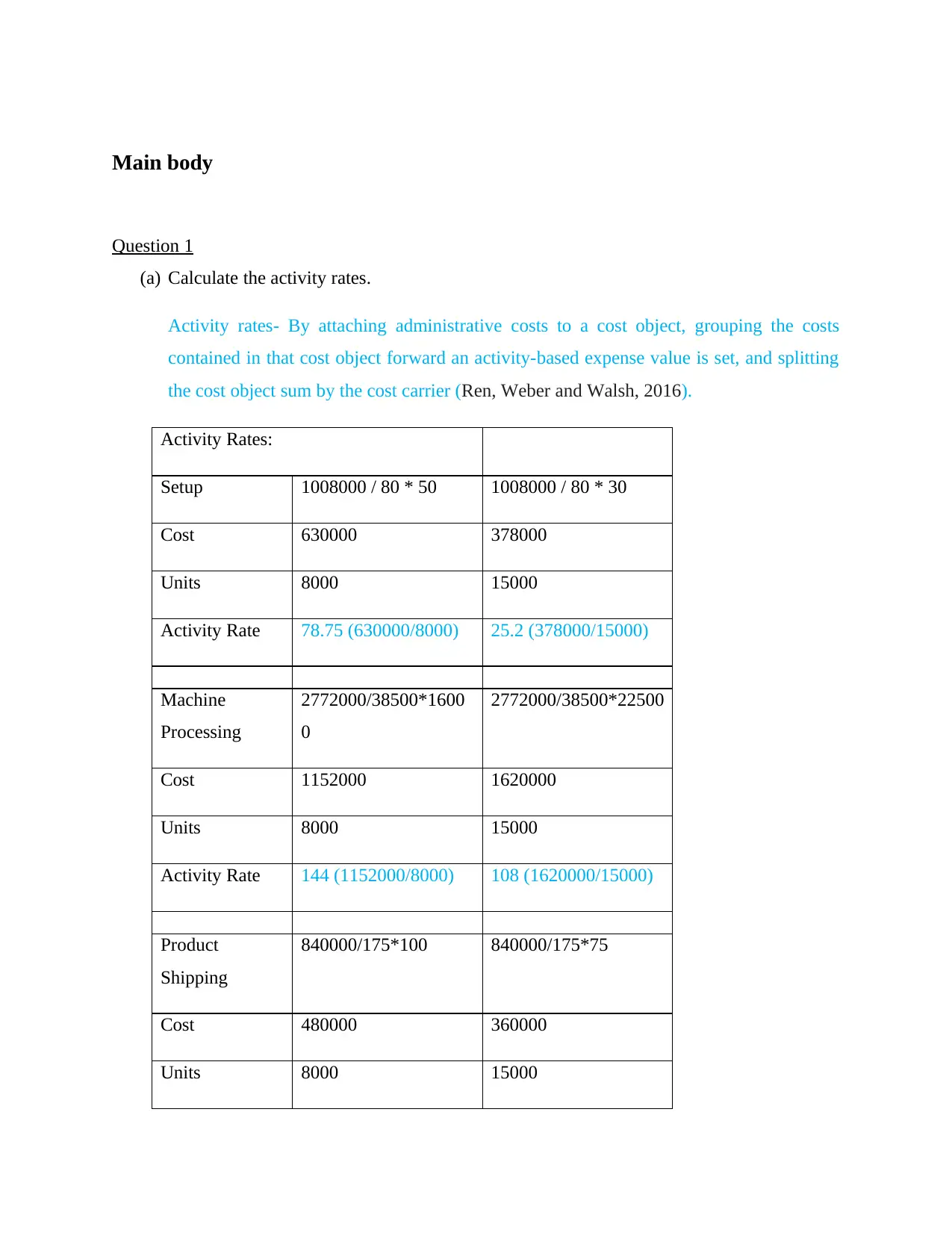
Main body
Question 1
(a) Calculate the activity rates.
Activity rates- By attaching administrative costs to a cost object, grouping the costs
contained in that cost object forward an activity-based expense value is set, and splitting
the cost object sum by the cost carrier (Ren, Weber and Walsh, 2016).
Activity Rates:
Setup 1008000 / 80 * 50 1008000 / 80 * 30
Cost 630000 378000
Units 8000 15000
Activity Rate 78.75 (630000/8000) 25.2 (378000/15000)
Machine
Processing
2772000/38500*1600
0
2772000/38500*22500
Cost 1152000 1620000
Units 8000 15000
Activity Rate 144 (1152000/8000) 108 (1620000/15000)
Product
Shipping
840000/175*100 840000/175*75
Cost 480000 360000
Units 8000 15000
Question 1
(a) Calculate the activity rates.
Activity rates- By attaching administrative costs to a cost object, grouping the costs
contained in that cost object forward an activity-based expense value is set, and splitting
the cost object sum by the cost carrier (Ren, Weber and Walsh, 2016).
Activity Rates:
Setup 1008000 / 80 * 50 1008000 / 80 * 30
Cost 630000 378000
Units 8000 15000
Activity Rate 78.75 (630000/8000) 25.2 (378000/15000)
Machine
Processing
2772000/38500*1600
0
2772000/38500*22500
Cost 1152000 1620000
Units 8000 15000
Activity Rate 144 (1152000/8000) 108 (1620000/15000)
Product
Shipping
840000/175*100 840000/175*75
Cost 480000 360000
Units 8000 15000
⊘ This is a preview!⊘
Do you want full access?
Subscribe today to unlock all pages.

Trusted by 1+ million students worldwide
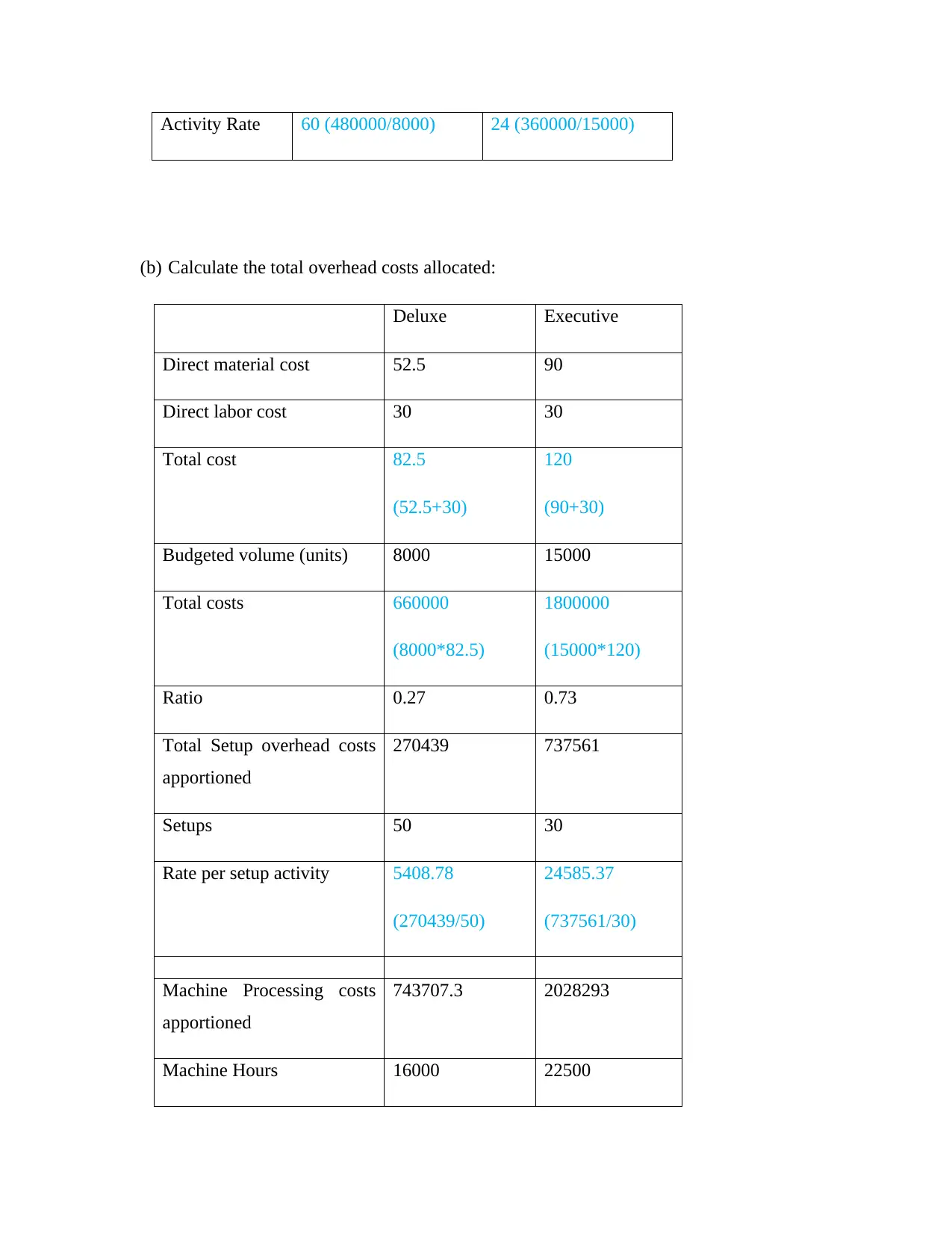
Activity Rate 60 (480000/8000) 24 (360000/15000)
(b) Calculate the total overhead costs allocated:
Deluxe Executive
Direct material cost 52.5 90
Direct labor cost 30 30
Total cost 82.5
(52.5+30)
120
(90+30)
Budgeted volume (units) 8000 15000
Total costs 660000
(8000*82.5)
1800000
(15000*120)
Ratio 0.27 0.73
Total Setup overhead costs
apportioned
270439 737561
Setups 50 30
Rate per setup activity 5408.78
(270439/50)
24585.37
(737561/30)
Machine Processing costs
apportioned
743707.3 2028293
Machine Hours 16000 22500
(b) Calculate the total overhead costs allocated:
Deluxe Executive
Direct material cost 52.5 90
Direct labor cost 30 30
Total cost 82.5
(52.5+30)
120
(90+30)
Budgeted volume (units) 8000 15000
Total costs 660000
(8000*82.5)
1800000
(15000*120)
Ratio 0.27 0.73
Total Setup overhead costs
apportioned
270439 737561
Setups 50 30
Rate per setup activity 5408.78
(270439/50)
24585.37
(737561/30)
Machine Processing costs
apportioned
743707.3 2028293
Machine Hours 16000 22500
Paraphrase This Document
Need a fresh take? Get an instant paraphrase of this document with our AI Paraphraser
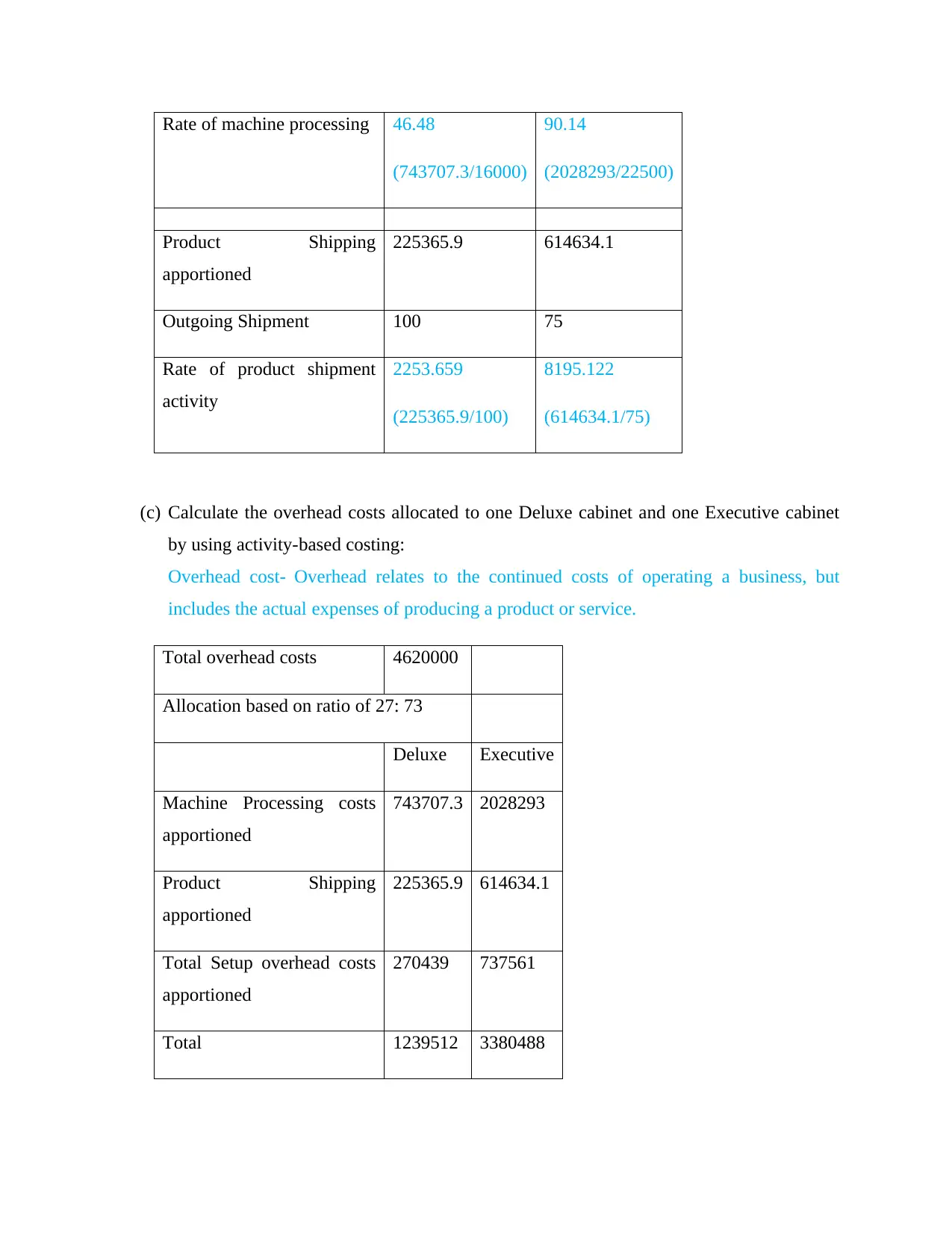
Rate of machine processing 46.48
(743707.3/16000)
90.14
(2028293/22500)
Product Shipping
apportioned
225365.9 614634.1
Outgoing Shipment 100 75
Rate of product shipment
activity
2253.659
(225365.9/100)
8195.122
(614634.1/75)
(c) Calculate the overhead costs allocated to one Deluxe cabinet and one Executive cabinet
by using activity-based costing:
Overhead cost- Overhead relates to the continued costs of operating a business, but
includes the actual expenses of producing a product or service.
Total overhead costs 4620000
Allocation based on ratio of 27: 73
Deluxe Executive
Machine Processing costs
apportioned
743707.3 2028293
Product Shipping
apportioned
225365.9 614634.1
Total Setup overhead costs
apportioned
270439 737561
Total 1239512 3380488
(743707.3/16000)
90.14
(2028293/22500)
Product Shipping
apportioned
225365.9 614634.1
Outgoing Shipment 100 75
Rate of product shipment
activity
2253.659
(225365.9/100)
8195.122
(614634.1/75)
(c) Calculate the overhead costs allocated to one Deluxe cabinet and one Executive cabinet
by using activity-based costing:
Overhead cost- Overhead relates to the continued costs of operating a business, but
includes the actual expenses of producing a product or service.
Total overhead costs 4620000
Allocation based on ratio of 27: 73
Deluxe Executive
Machine Processing costs
apportioned
743707.3 2028293
Product Shipping
apportioned
225365.9 614634.1
Total Setup overhead costs
apportioned
270439 737561
Total 1239512 3380488
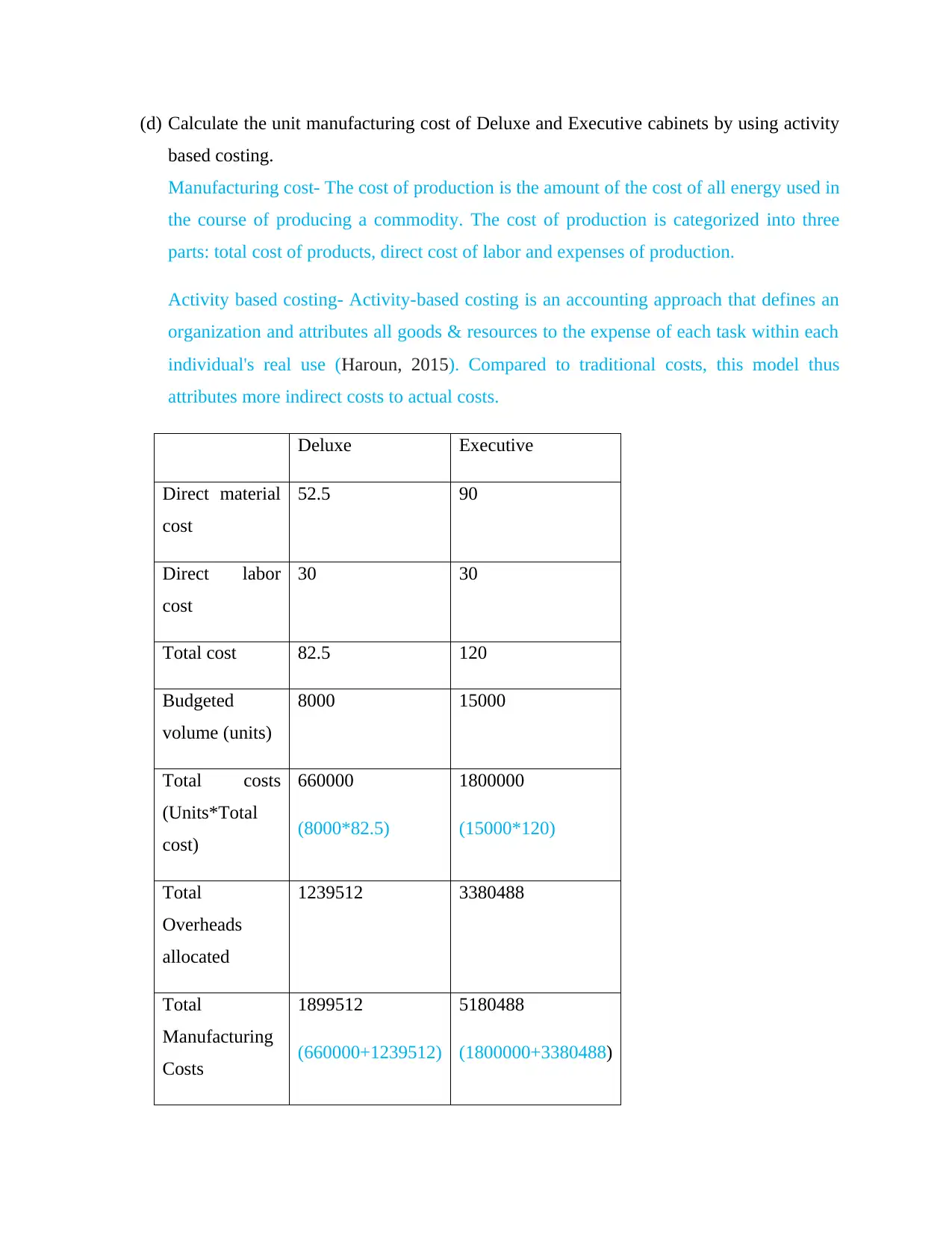
(d) Calculate the unit manufacturing cost of Deluxe and Executive cabinets by using activity
based costing.
Manufacturing cost- The cost of production is the amount of the cost of all energy used in
the course of producing a commodity. The cost of production is categorized into three
parts: total cost of products, direct cost of labor and expenses of production.
Activity based costing- Activity-based costing is an accounting approach that defines an
organization and attributes all goods & resources to the expense of each task within each
individual's real use (Haroun, 2015). Compared to traditional costs, this model thus
attributes more indirect costs to actual costs.
Deluxe Executive
Direct material
cost
52.5 90
Direct labor
cost
30 30
Total cost 82.5 120
Budgeted
volume (units)
8000 15000
Total costs
(Units*Total
cost)
660000
(8000*82.5)
1800000
(15000*120)
Total
Overheads
allocated
1239512 3380488
Total
Manufacturing
Costs
1899512
(660000+1239512)
5180488
(1800000+3380488)
based costing.
Manufacturing cost- The cost of production is the amount of the cost of all energy used in
the course of producing a commodity. The cost of production is categorized into three
parts: total cost of products, direct cost of labor and expenses of production.
Activity based costing- Activity-based costing is an accounting approach that defines an
organization and attributes all goods & resources to the expense of each task within each
individual's real use (Haroun, 2015). Compared to traditional costs, this model thus
attributes more indirect costs to actual costs.
Deluxe Executive
Direct material
cost
52.5 90
Direct labor
cost
30 30
Total cost 82.5 120
Budgeted
volume (units)
8000 15000
Total costs
(Units*Total
cost)
660000
(8000*82.5)
1800000
(15000*120)
Total
Overheads
allocated
1239512 3380488
Total
Manufacturing
Costs
1899512
(660000+1239512)
5180488
(1800000+3380488)
⊘ This is a preview!⊘
Do you want full access?
Subscribe today to unlock all pages.

Trusted by 1+ million students worldwide
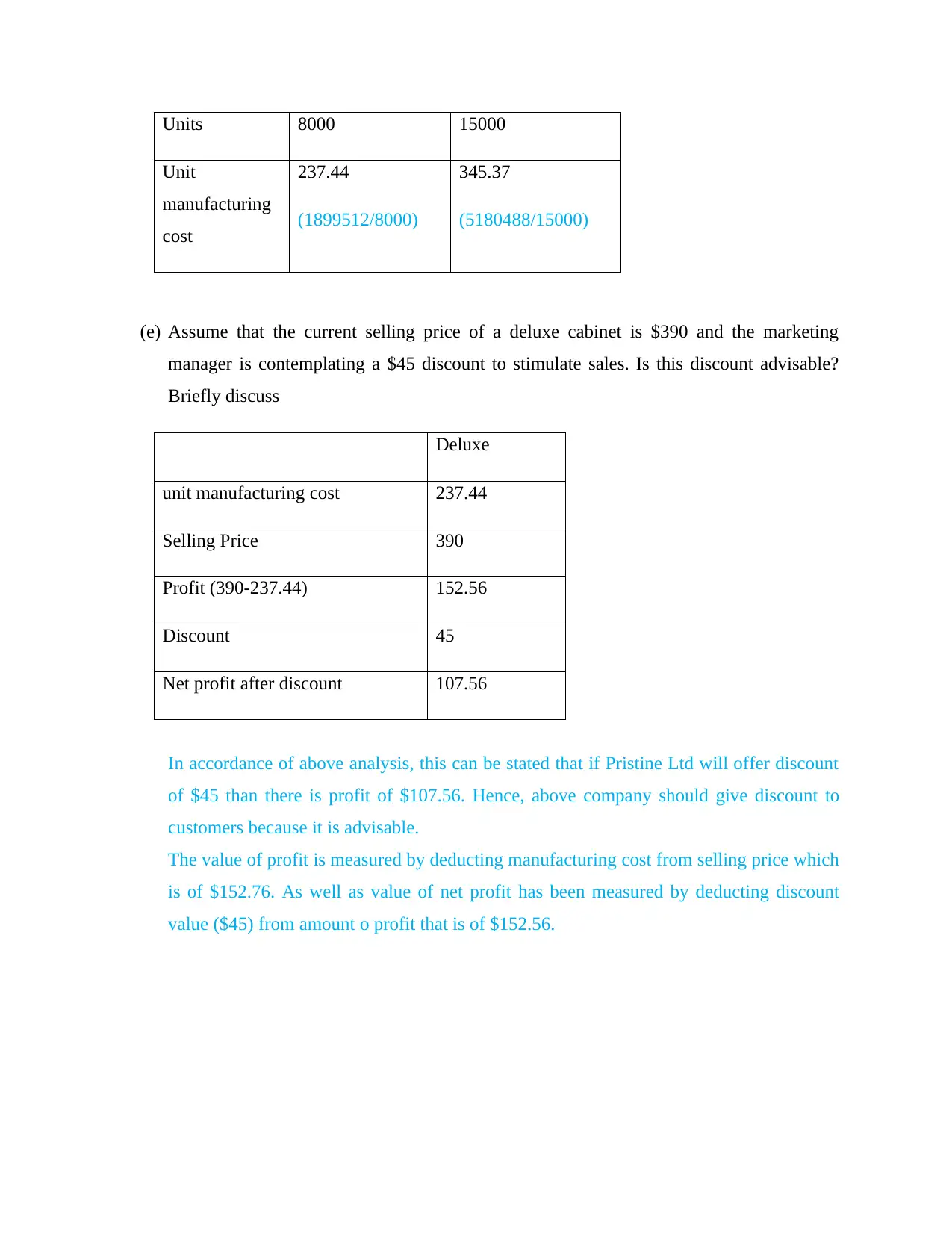
Units 8000 15000
Unit
manufacturing
cost
237.44
(1899512/8000)
345.37
(5180488/15000)
(e) Assume that the current selling price of a deluxe cabinet is $390 and the marketing
manager is contemplating a $45 discount to stimulate sales. Is this discount advisable?
Briefly discuss
Deluxe
unit manufacturing cost 237.44
Selling Price 390
Profit (390-237.44) 152.56
Discount 45
Net profit after discount 107.56
In accordance of above analysis, this can be stated that if Pristine Ltd will offer discount
of $45 than there is profit of $107.56. Hence, above company should give discount to
customers because it is advisable.
The value of profit is measured by deducting manufacturing cost from selling price which
is of $152.76. As well as value of net profit has been measured by deducting discount
value ($45) from amount o profit that is of $152.56.
Unit
manufacturing
cost
237.44
(1899512/8000)
345.37
(5180488/15000)
(e) Assume that the current selling price of a deluxe cabinet is $390 and the marketing
manager is contemplating a $45 discount to stimulate sales. Is this discount advisable?
Briefly discuss
Deluxe
unit manufacturing cost 237.44
Selling Price 390
Profit (390-237.44) 152.56
Discount 45
Net profit after discount 107.56
In accordance of above analysis, this can be stated that if Pristine Ltd will offer discount
of $45 than there is profit of $107.56. Hence, above company should give discount to
customers because it is advisable.
The value of profit is measured by deducting manufacturing cost from selling price which
is of $152.76. As well as value of net profit has been measured by deducting discount
value ($45) from amount o profit that is of $152.56.
Paraphrase This Document
Need a fresh take? Get an instant paraphrase of this document with our AI Paraphraser
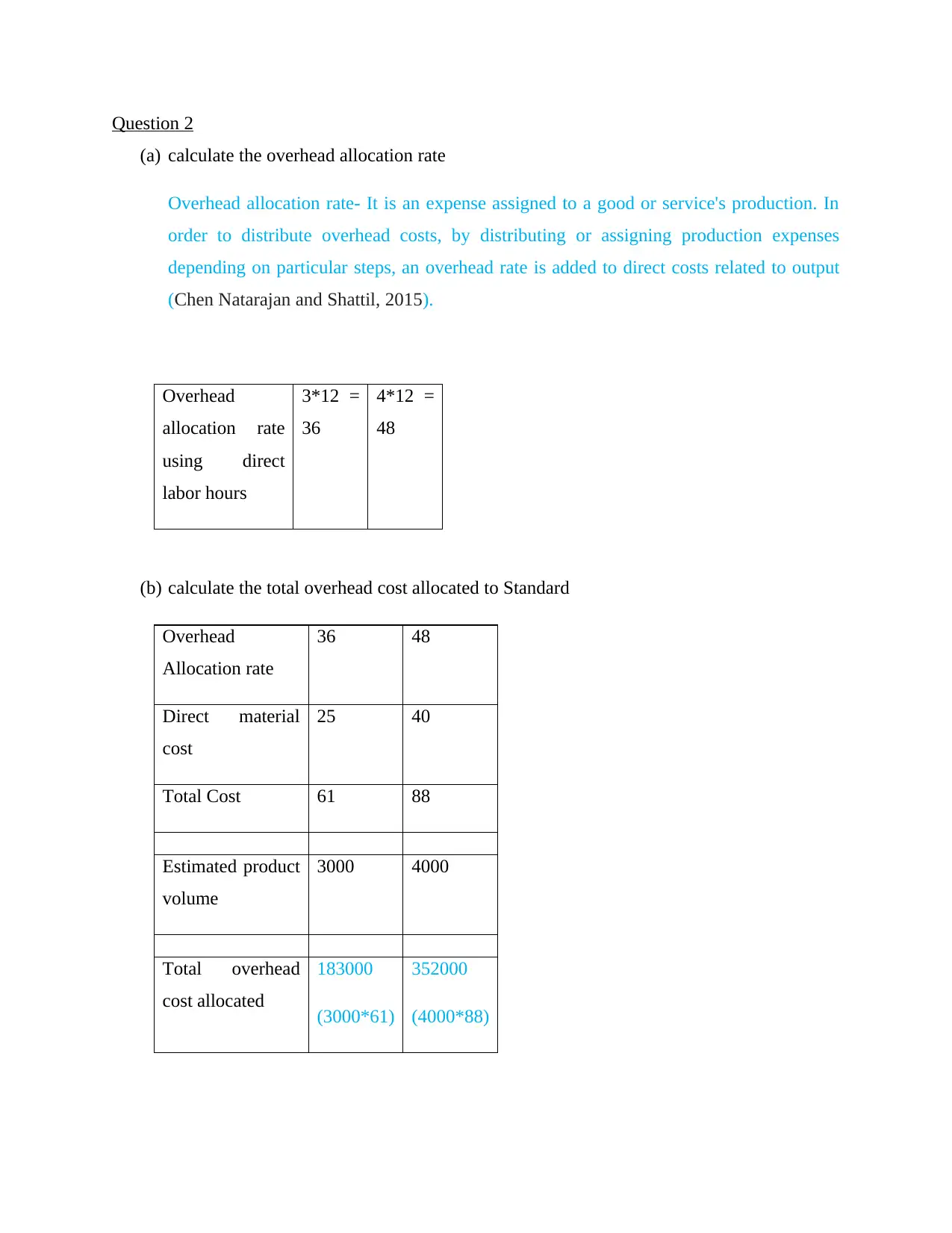
Question 2
(a) calculate the overhead allocation rate
Overhead allocation rate- It is an expense assigned to a good or service's production. In
order to distribute overhead costs, by distributing or assigning production expenses
depending on particular steps, an overhead rate is added to direct costs related to output
(Chen Natarajan and Shattil, 2015).
Overhead
allocation rate
using direct
labor hours
3*12 =
36
4*12 =
48
(b) calculate the total overhead cost allocated to Standard
Overhead
Allocation rate
36 48
Direct material
cost
25 40
Total Cost 61 88
Estimated product
volume
3000 4000
Total overhead
cost allocated
183000
(3000*61)
352000
(4000*88)
(a) calculate the overhead allocation rate
Overhead allocation rate- It is an expense assigned to a good or service's production. In
order to distribute overhead costs, by distributing or assigning production expenses
depending on particular steps, an overhead rate is added to direct costs related to output
(Chen Natarajan and Shattil, 2015).
Overhead
allocation rate
using direct
labor hours
3*12 =
36
4*12 =
48
(b) calculate the total overhead cost allocated to Standard
Overhead
Allocation rate
36 48
Direct material
cost
25 40
Total Cost 61 88
Estimated product
volume
3000 4000
Total overhead
cost allocated
183000
(3000*61)
352000
(4000*88)
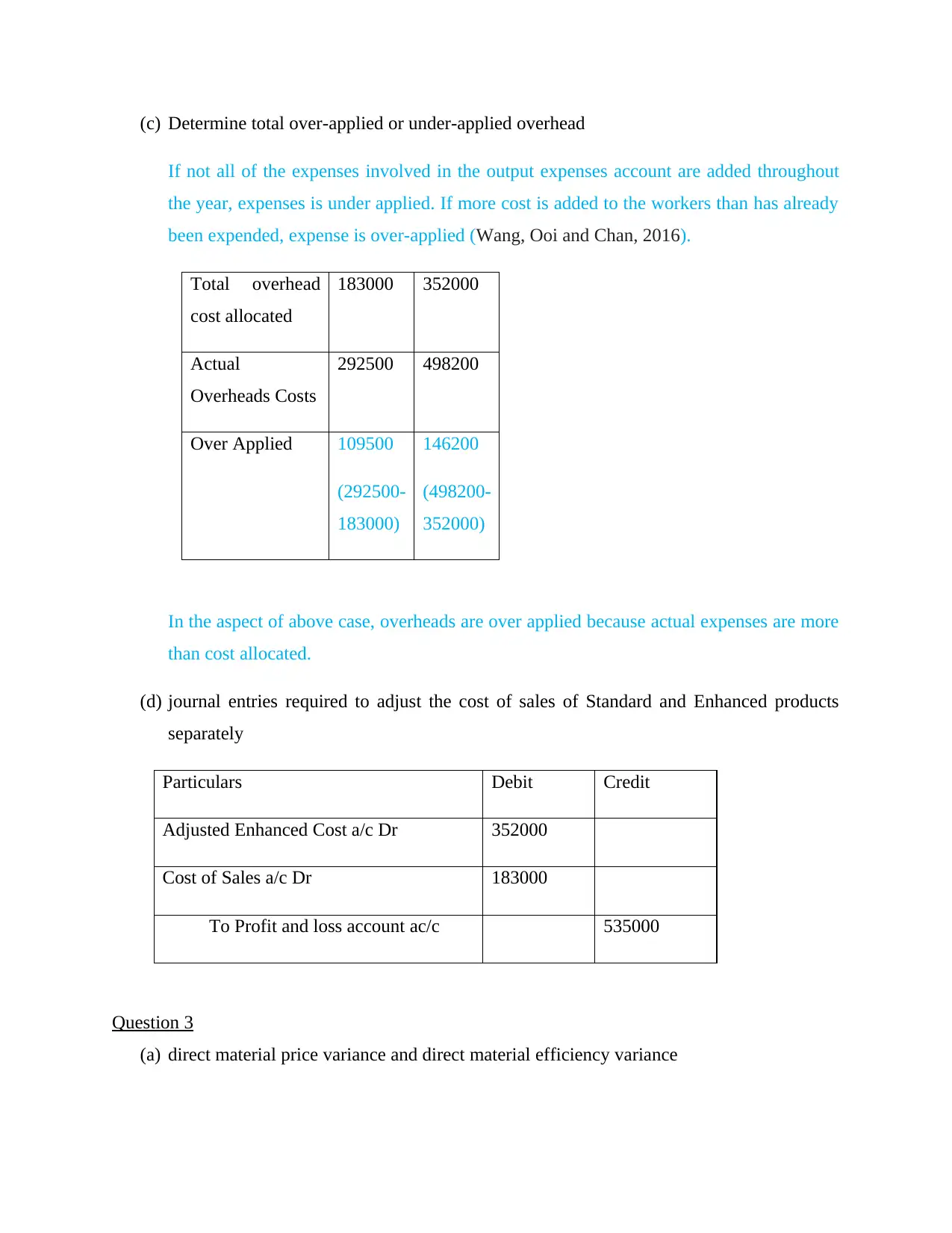
(c) Determine total over-applied or under-applied overhead
If not all of the expenses involved in the output expenses account are added throughout
the year, expenses is under applied. If more cost is added to the workers than has already
been expended, expense is over-applied (Wang, Ooi and Chan, 2016).
Total overhead
cost allocated
183000 352000
Actual
Overheads Costs
292500 498200
Over Applied 109500
(292500-
183000)
146200
(498200-
352000)
In the aspect of above case, overheads are over applied because actual expenses are more
than cost allocated.
(d) journal entries required to adjust the cost of sales of Standard and Enhanced products
separately
Particulars Debit Credit
Adjusted Enhanced Cost a/c Dr 352000
Cost of Sales a/c Dr 183000
To Profit and loss account ac/c 535000
Question 3
(a) direct material price variance and direct material efficiency variance
If not all of the expenses involved in the output expenses account are added throughout
the year, expenses is under applied. If more cost is added to the workers than has already
been expended, expense is over-applied (Wang, Ooi and Chan, 2016).
Total overhead
cost allocated
183000 352000
Actual
Overheads Costs
292500 498200
Over Applied 109500
(292500-
183000)
146200
(498200-
352000)
In the aspect of above case, overheads are over applied because actual expenses are more
than cost allocated.
(d) journal entries required to adjust the cost of sales of Standard and Enhanced products
separately
Particulars Debit Credit
Adjusted Enhanced Cost a/c Dr 352000
Cost of Sales a/c Dr 183000
To Profit and loss account ac/c 535000
Question 3
(a) direct material price variance and direct material efficiency variance
⊘ This is a preview!⊘
Do you want full access?
Subscribe today to unlock all pages.

Trusted by 1+ million students worldwide
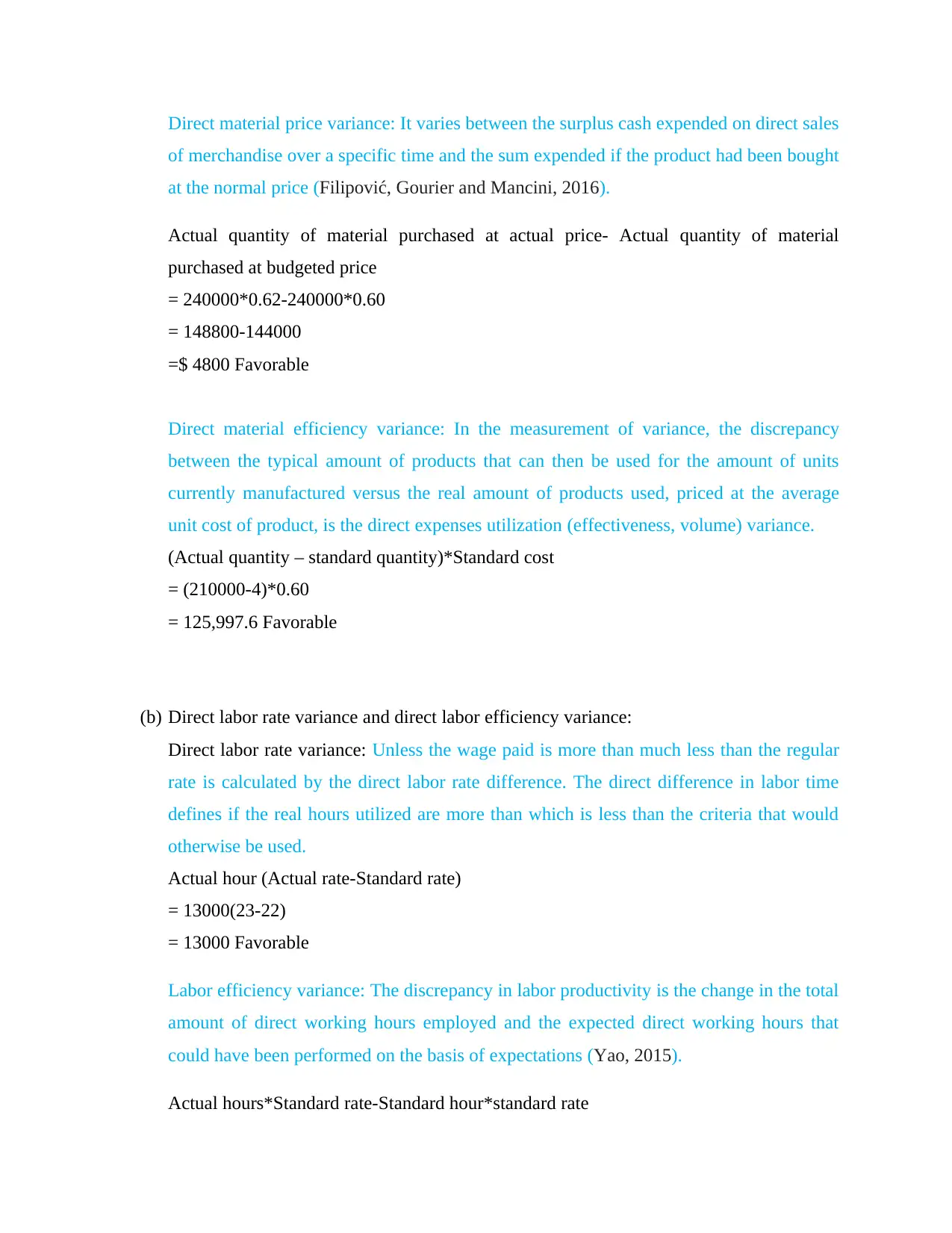
Direct material price variance: It varies between the surplus cash expended on direct sales
of merchandise over a specific time and the sum expended if the product had been bought
at the normal price (Filipović, Gourier and Mancini, 2016).
Actual quantity of material purchased at actual price- Actual quantity of material
purchased at budgeted price
= 240000*0.62-240000*0.60
= 148800-144000
=$ 4800 Favorable
Direct material efficiency variance: In the measurement of variance, the discrepancy
between the typical amount of products that can then be used for the amount of units
currently manufactured versus the real amount of products used, priced at the average
unit cost of product, is the direct expenses utilization (effectiveness, volume) variance.
(Actual quantity – standard quantity)*Standard cost
= (210000-4)*0.60
= 125,997.6 Favorable
(b) Direct labor rate variance and direct labor efficiency variance:
Direct labor rate variance: Unless the wage paid is more than much less than the regular
rate is calculated by the direct labor rate difference. The direct difference in labor time
defines if the real hours utilized are more than which is less than the criteria that would
otherwise be used.
Actual hour (Actual rate-Standard rate)
= 13000(23-22)
= 13000 Favorable
Labor efficiency variance: The discrepancy in labor productivity is the change in the total
amount of direct working hours employed and the expected direct working hours that
could have been performed on the basis of expectations (Yao, 2015).
Actual hours*Standard rate-Standard hour*standard rate
of merchandise over a specific time and the sum expended if the product had been bought
at the normal price (Filipović, Gourier and Mancini, 2016).
Actual quantity of material purchased at actual price- Actual quantity of material
purchased at budgeted price
= 240000*0.62-240000*0.60
= 148800-144000
=$ 4800 Favorable
Direct material efficiency variance: In the measurement of variance, the discrepancy
between the typical amount of products that can then be used for the amount of units
currently manufactured versus the real amount of products used, priced at the average
unit cost of product, is the direct expenses utilization (effectiveness, volume) variance.
(Actual quantity – standard quantity)*Standard cost
= (210000-4)*0.60
= 125,997.6 Favorable
(b) Direct labor rate variance and direct labor efficiency variance:
Direct labor rate variance: Unless the wage paid is more than much less than the regular
rate is calculated by the direct labor rate difference. The direct difference in labor time
defines if the real hours utilized are more than which is less than the criteria that would
otherwise be used.
Actual hour (Actual rate-Standard rate)
= 13000(23-22)
= 13000 Favorable
Labor efficiency variance: The discrepancy in labor productivity is the change in the total
amount of direct working hours employed and the expected direct working hours that
could have been performed on the basis of expectations (Yao, 2015).
Actual hours*Standard rate-Standard hour*standard rate
Paraphrase This Document
Need a fresh take? Get an instant paraphrase of this document with our AI Paraphraser
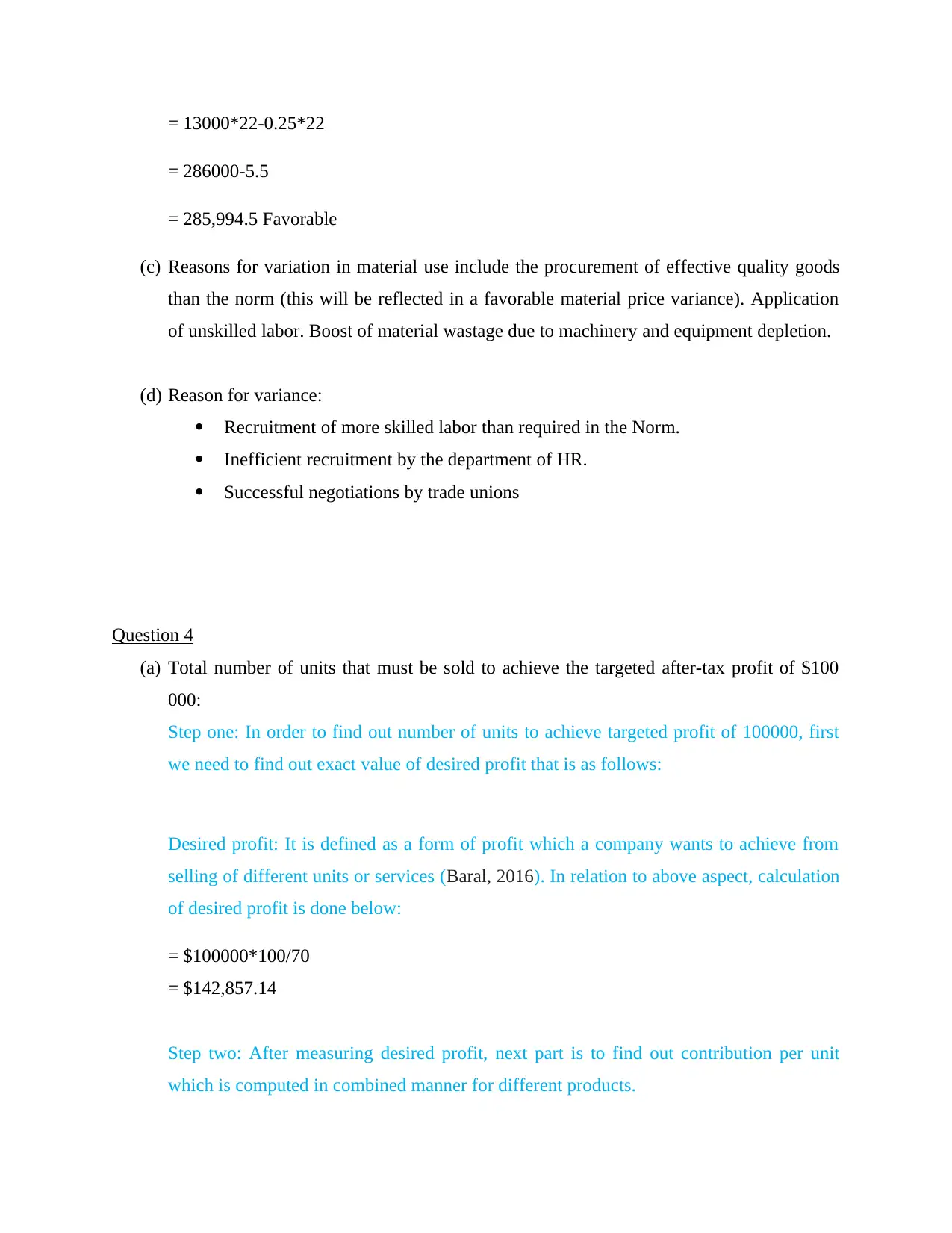
= 13000*22-0.25*22
= 286000-5.5
= 285,994.5 Favorable
(c) Reasons for variation in material use include the procurement of effective quality goods
than the norm (this will be reflected in a favorable material price variance). Application
of unskilled labor. Boost of material wastage due to machinery and equipment depletion.
(d) Reason for variance:
Recruitment of more skilled labor than required in the Norm.
Inefficient recruitment by the department of HR.
Successful negotiations by trade unions
Question 4
(a) Total number of units that must be sold to achieve the targeted after-tax profit of $100
000:
Step one: In order to find out number of units to achieve targeted profit of 100000, first
we need to find out exact value of desired profit that is as follows:
Desired profit: It is defined as a form of profit which a company wants to achieve from
selling of different units or services (Baral, 2016). In relation to above aspect, calculation
of desired profit is done below:
= $100000*100/70
= $142,857.14
Step two: After measuring desired profit, next part is to find out contribution per unit
which is computed in combined manner for different products.
= 286000-5.5
= 285,994.5 Favorable
(c) Reasons for variation in material use include the procurement of effective quality goods
than the norm (this will be reflected in a favorable material price variance). Application
of unskilled labor. Boost of material wastage due to machinery and equipment depletion.
(d) Reason for variance:
Recruitment of more skilled labor than required in the Norm.
Inefficient recruitment by the department of HR.
Successful negotiations by trade unions
Question 4
(a) Total number of units that must be sold to achieve the targeted after-tax profit of $100
000:
Step one: In order to find out number of units to achieve targeted profit of 100000, first
we need to find out exact value of desired profit that is as follows:
Desired profit: It is defined as a form of profit which a company wants to achieve from
selling of different units or services (Baral, 2016). In relation to above aspect, calculation
of desired profit is done below:
= $100000*100/70
= $142,857.14
Step two: After measuring desired profit, next part is to find out contribution per unit
which is computed in combined manner for different products.
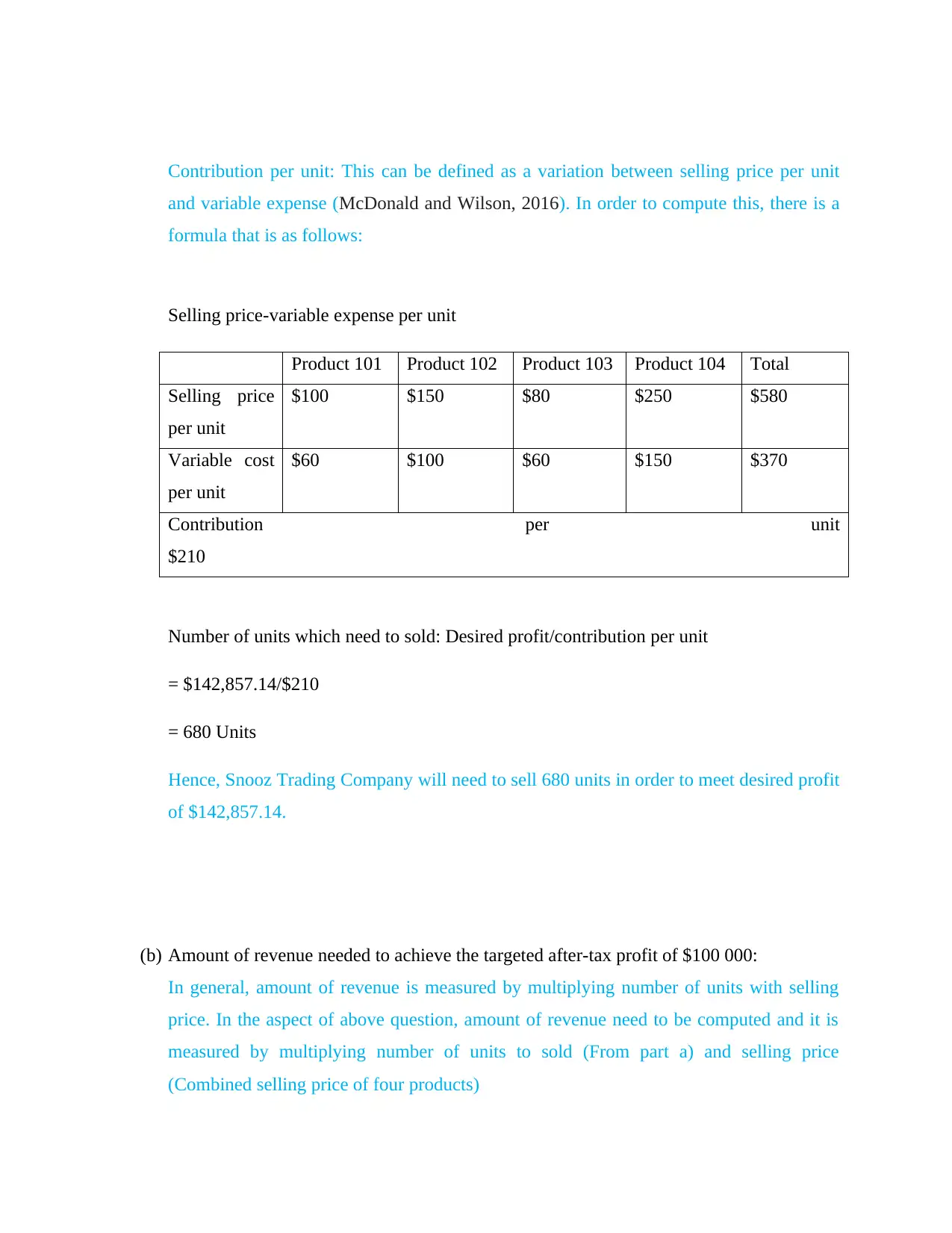
Contribution per unit: This can be defined as a variation between selling price per unit
and variable expense (McDonald and Wilson, 2016). In order to compute this, there is a
formula that is as follows:
Selling price-variable expense per unit
Product 101 Product 102 Product 103 Product 104 Total
Selling price
per unit
$100 $150 $80 $250 $580
Variable cost
per unit
$60 $100 $60 $150 $370
Contribution per unit
$210
Number of units which need to sold: Desired profit/contribution per unit
= $142,857.14/$210
= 680 Units
Hence, Snooz Trading Company will need to sell 680 units in order to meet desired profit
of $142,857.14.
(b) Amount of revenue needed to achieve the targeted after-tax profit of $100 000:
In general, amount of revenue is measured by multiplying number of units with selling
price. In the aspect of above question, amount of revenue need to be computed and it is
measured by multiplying number of units to sold (From part a) and selling price
(Combined selling price of four products)
and variable expense (McDonald and Wilson, 2016). In order to compute this, there is a
formula that is as follows:
Selling price-variable expense per unit
Product 101 Product 102 Product 103 Product 104 Total
Selling price
per unit
$100 $150 $80 $250 $580
Variable cost
per unit
$60 $100 $60 $150 $370
Contribution per unit
$210
Number of units which need to sold: Desired profit/contribution per unit
= $142,857.14/$210
= 680 Units
Hence, Snooz Trading Company will need to sell 680 units in order to meet desired profit
of $142,857.14.
(b) Amount of revenue needed to achieve the targeted after-tax profit of $100 000:
In general, amount of revenue is measured by multiplying number of units with selling
price. In the aspect of above question, amount of revenue need to be computed and it is
measured by multiplying number of units to sold (From part a) and selling price
(Combined selling price of four products)
⊘ This is a preview!⊘
Do you want full access?
Subscribe today to unlock all pages.

Trusted by 1+ million students worldwide
1 out of 17
Your All-in-One AI-Powered Toolkit for Academic Success.
+13062052269
info@desklib.com
Available 24*7 on WhatsApp / Email
![[object Object]](/_next/static/media/star-bottom.7253800d.svg)
Unlock your academic potential
Copyright © 2020–2025 A2Z Services. All Rights Reserved. Developed and managed by ZUCOL.